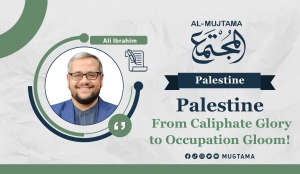
Ali Ibrahim
Palestine: From Caliphate Glory to Occupation Gloom!
March 06, 2024Here we are, a century after the overthrow of the Caliphate, and Palestine continues to suffer under a ruthless occupation, relentless settlement, horrifying massacres, and grand schemes targeting Jerusalem and the Al-Aqsa Mosque, along with direct attacks on the sanctities of Palestine and the Muslim Ummah.
The current plight of Palestine provokes a comparison with its state under the blessed Ottoman Caliphate and its current conditions under the brutal occupation.
The Ottoman Empire was a great Islamic state since its foundation, experiencing periods of strength and weakness much like other Islamic states. However, it remained an invincible barrier against colonial powers. One of the foundational principles of the Ottoman Caliphate is documented in history, portraying the advice given by the founder of the empire, Osman, the son of Ertuğrul, to his son Orhan. This advice encompassed a constitution, an ethical framework, and a legal foundation that guided the Ottoman state throughout its existence.
Sultan Suleiman the Magnificent was an exemplary model of the Ottoman interest in Palestine and its sanctities
Osman says, “O my son, beware of engaging in anything that Allah, the Lord of the worlds, did not command. If you face a dilemma in governance, seek guidance from the scholars of religion. O my son, honor those who obey you, be generous to the soldiers, and do not let the Shaitan deceive you with your soldiers, efforts, and wealth. Avoid distancing yourself from the righteous. O my son, you know that our ultimate goal is to please Allah, the Lord of the worlds, and that through jihad, the light of our religion will spread across all horizons, seeking the satisfaction of Allah, the Almighty. My son, we are not among those who wage wars for the lust of power or individual control. We live and die for Islam, and this, my son, is what you are destined for.”
The Ottoman Interest in Palestine
Sultan Suleiman the Magnificent served as a pioneering model for Ottoman interest in Jerusalem, particularly in Palestine. During his reign, the city witnessed direct attention from the Sultan. The renowned traveler, Evliya Çelebi, shares a charming account of the reason for the Sultan’s interest in the city while speaking of his visit in 1082 AH / 1672 CE. He said that Suleiman had a vision of the Prophet Muhammad (peace be upon him), telling him that he would achieve many victories and that he must invest the spoils of war in adorning Mecca, Medina, fortifying Jerusalem against potential invaders, and rebuilding the city of Jerusalem.
Apart from the historical accuracy of the account, Sultan Suleiman took special care of the Al-Aqsa Mosque. In 935 AH / 1528 CE, the first renovation of the Dome of the Rock’s prayer hall took place. In 949 AH / 1542 CE, the Sultan ordered the renovation of the structure of the Dome of the Rock, where he built 16 gilded glass windows and refurbished it with majestic blue tiles, renowned in Istanbul's mosques. He also renewed the doors and walls of the Al-Aqsa Mosque, extended the wall of Jerusalem that is still standing today, and ensured a water supply to the city by connecting it to ponds known as “Solomon's Pools,” which continue to exist under his name. Not only this, but he assigned to these establishments endowments for their maintenance.
The Ottoman Sultans continued to care for Palestine and Jerusalem until the end of their era. They linked Palestine to the Hejaz Railway, linking Istanbul to Medina, which facilitated the Muslims' Hajj (pilgrimage). Additionally, in 1892, a railway line connected Jerusalem to the port of Jaffa, and telegraph lines were established between Jerusalem, Egypt, Beirut, and Europe. The municipal hospital was established in the western part of the city in 1891, and electricity was introduced to Jerusalem in 1914.
The Ottomans linked Palestine to the Hejaz Railway between Istanbul and Medina
But today, the arms of the occupation are working to demolish Islamic monuments in Jerusalem and Palestine, intentionally distorting them. According to Palestinian sources, the occupation authorities have demolished more than 1200 mosques since 1948, some of which date back to the Mamluk or Ottoman periods. Many of the remaining mosques have been turned into warehouses, stables, and places for sugar and misconduct. The latest of these was the bombing of the Great Omari Mosque during the barbaric aggression on the Gaza Strip. These heinous crimes also involve the desecration of Muslim cemeteries, building settlement projects on Muslim graves, and endowments.
Confronting Jewish Settlements
Efforts to confront Jewish settlements in Palestine began during the reign of Ottoman Sultan Abdulmejid I. He ordered the Jerusalem administration to reclaim a piece of land in the city that had been purchased by a British Jewish doctor, stipulating that it should be sold to any Ottoman citizen. Facing Jewish manipulation and collusion with foreign consulates against the Ottoman administration, Sultan Abdulhamid II issued a law in March 1883 prohibiting the sale of immovable property in the Ottoman Empire to foreign Jews.
In 1884, the Sultan issued another decree prohibiting Jewish migration, allowing foreigners among them to visit Palestine for no more than three months. Sultan Abdulhamid II rejected Zionist proposals to buy Palestine and establish their state on it, paying a high price for maintaining such positions.
In contrast to these efforts, the British Mandate opened the door for European Jewish colonization in Palestine. Sources indicate that the number of Jews in Palestine before the fall of the Ottoman Caliphate was about 50,000, and by the end of the British Mandate in 1948, it had reached approximately 650,000 Jewish settlers, constituting about 29.5% of the population. Britain not only facilitated the increase in the number of settlers but also facilitated their control over more lands.
The Zionist occupation worked to solidify a Jewish identity in Palestine in general and Jerusalem in particular
In 1918, the total land owned by Jews in Palestine was 650,000 dunams, representing 2% of the total area. This percentage increased to 8% by 1948, allowing settlers to control significant parts of Palestine through force and land acquisition.
Throughout Islamic history in Palestine, there was no religious persecution except during brief periods influenced by foreign ideas. The residents of Palestine and Muslims in various regions enjoyed religious tolerance under the Caliphate, granting people of different religions their religious freedom and protecting both churches and mosques.
Vincent Lemire, a French researcher, testified that until the early 20th century, Jerusalem was not a battleground for nationalist battles or the interests of major powers. The city was far from any geopolitical conflicts and maintained harmony among its diverse religious communities under Ottoman rule, which lasted from 1517 until it was replaced by British occupation.
This testimony confirms the period of peace and security that Palestine experienced under Ottoman rule. The Ottoman system, based on the “millet” law and grounded in Sharia, allowed for distinctive economic and cultural development. In contrast, the Crusader occupation led to the killing of thousands of Muslims and Eastern Christians alike in Jerusalem. This religious elimination was not confined to the Crusaders alone; rather, the Zionist occupation also worked to establish a Jewish identity in Palestine in general and Jerusalem in particular.
-------------------------------------------------------------


